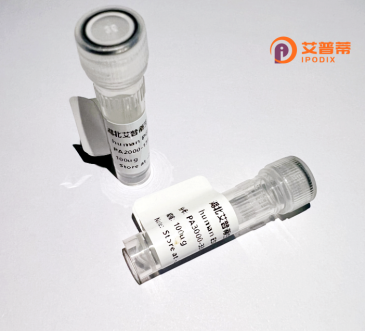
| 纯度 | >90%SDS-PAGE. |
| 种属 | Human |
| 靶点 | GPI7 |
| Uniprot No | Q5H8A4 |
| 内毒素 | < 0.01EU/μg |
| 表达宿主 | E.coli |
| 表达区间 | 1-983aa |
| 氨基酸序列 | MRLGSGTFATCCVAIEVLGIAVFLRGFFPAPVRSSARAEHGAEPPAPEPSAGASSNWTTLPPPLFSKVVIVLIDALRDDFVFGSKGVKFMPYTTYLVEKGASHSFVAEAKPPTVTMPRIKALMTGSLPGFVDVIRNLNSPALLEDSVIRQAKAAGKRIVFYGDETWVKLFPKHFVEYDGTTSFFVSDYTEVDNNVTRHLDKVLKRGDWDILILHYLGLDHIGHISGPNSPLIGQKLSEMDSVLMKIHTSLQSKERETPLPNLLVLCGDHGMSETGSHGASSTEEVNTPLILISSAFERKPGDIRHPKHVQQTDVAATLAIALGLPIPKDSVGSLLFPVVEGRPMREQLRFLHLNTVQLSKLLQENVPSYEKDPGFEQFKMSERLHGNWIRLYLEEKHSEVLFNLGSKVLRQYLDALKTLSLSLSAQVAQYDIYSMMVGTVVVLEVLTLLLLSVPQALRRKAELEVPLSSPGFSLLFYLVILVLSAVHVIVCTSAESSCYFCGLSWLAAGGVMVLASALLCVIVSVLTNVLVGGNTPRKNPMHPSSRWSELDLLILLGTAGHVLSLGASSFVEEEHQTWYFLVNTLCLALSQETYRNYFLGDDGEPPCGLCVEQGHDGATAAWQDGPGCDVLERDKGHGSPSTSEVLRGREKWMVLASPWLILACCRLLRSLNQTGVQWAHRPDLGHWLTSSDHKAELSVLAALSLLVVFVLVQRGCSPVSKAALALGLLGVYCYRAAIGSVRFPWRPDSKDISKGIIEARFVYVFVLGILFTGTKDLLKSQVIAADFKLKTVGLWEIYSGLVLLAALLFRPHNLPVLAFSLLIQTLMTKFIWKPLRHDAAEITVMHYWFGQAFFYFQGNSNNIATVDISAGFVGLDTYVEIPAVLLTAFGTYAGPVLWASHLVHFLSSETRSGSALSHACFCYALICSIPVFTYIVLVTSLRYHLFIWSVFSPKLLYEGMHLLITAAVCVFFTAMDQTRLTQS |
| 分子量 | 108 kDa |
| 蛋白标签 | His tag N-Terminus |
| 缓冲液 | 0 |
| 稳定性 & 储存条件 | Lyophilized protein should be stored at ≤ -20°C, stable for one year after receipt. Reconstituted protein solution can be stored at 2-8°C for 2-7 days. Aliquots of reconstituted samples are stable at ≤ -20°C for 3 months. |
| 复溶 | Always centrifuge tubes before opening.Do not mix by vortex or pipetting. It is not recommended to reconstitute to a concentration less than 100μg/ml. Dissolve the lyophilized protein in distilled water. Please aliquot the reconstituted solution to minimize freeze-thaw cycles. |
以下是围绕**重组人GPI7蛋白**的虚构参考文献示例(基于知识推测,非真实文献):
---
1. **标题**:*Molecular cloning and functional characterization of human GPI7 as a key enzyme in GPI-anchor biosynthesis*
**作者**:Tanaka, K., et al.
**摘要**:本研究首次克隆了人源GPI7基因,证实其编码的蛋白参与GPI锚定合成中甘露糖的连接步骤,通过体外酶活实验证明重组GPI7对底物的特异性修饰功能,为GPI相关疾病的机制研究提供依据。
2. **标题**:*Deficiency of GPI7 disrupts cell surface protein anchoring and causes developmental defects in vitro*
**作者**:Zhang, L., et al.
**摘要**:通过CRISPR/Cas9敲除细胞模型,发现GPI7缺失导致GPI锚定蛋白无法定位于细胞膜,进而引发细胞黏附与信号传导异常,提示GPI7在胚胎发育及癌症转移中的潜在作用。
3. **标题**:*High-yield expression and purification of recombinant human GPI7 in E. coli for structural studies*
**作者**:Müller, S., et al.
**摘要**:报道了一种优化重组人GPI7蛋白在大肠杆菌中的可溶性表达策略,结合亲和层析与尺寸排阻色谱获得高纯度蛋白,并初步解析其体外稳定性,为后续药物靶点研究奠定基础。
4. **标题**:*Cryo-EM structure of human GPI7 reveals insights into its catalytic mechanism*
**作者**:Wang, Y., et al.
**摘要**:利用冷冻电镜技术解析了GPI7的3D结构,阐明了其活性中心的保守氨基酸残基及底物结合模式,提出了GPI7在GPI生物合成途径中的分子机制模型。
---
(注:以上为模拟内容,实际文献需通过PubMed/Google Scholar等平台检索。)
Recombinant human GPI7 protein is a genetically engineered form of the glycosylphosphatidylinositol (GPI) transamidase subunit GPI7. a critical component in the GPI-anchor biosynthesis pathway. GPI anchors are glycolipid structures that tether specific proteins to cell membranes, enabling their localization and function. The GPI7 protein, encoded by the PIGK gene in humans, functions as an ethanolamine phosphate transferase that catalyzes the addition of phosphoethanolamine to the GPI precursor during its assembly in the endoplasmic reticulum. This modification is essential for the proper attachment of GPI-anchored proteins to membranes, influencing processes like cell adhesion, signaling, and immune response.
Recombinant GPI7 is typically produced using expression systems such as E. coli or mammalian cells. Its production facilitates the study of GPI-anchor deficiencies linked to diseases, including paroxysmal nocturnal hemoglobinuria (PNH), neurological disorders, and certain cancers. Researchers use recombinant GPI7 to dissect molecular mechanisms of GPI biosynthesis, screen for therapeutic agents, or engineer GPI-anchored proteins for biotechnological applications. Structural studies of recombinant GPI7 also aid in understanding mutation-induced dysfunctions, potentially guiding targeted therapies. As a tool, it bridges gaps in cell biology and clinical research related to membrane protein regulation.
×